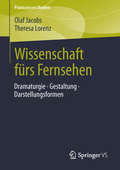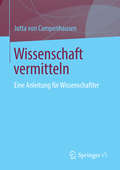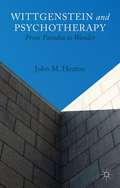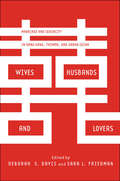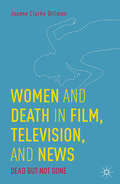- Table View
- List View
William Cobbett, the Press and Rural England: Radicalism and the Fourth Estate, 1792-1835 (Palgrave Studies in Nineteenth-Century Writing and Culture)
by James GrandeWilliam Cobbett, the Press and Rural England offers a thorough re-appraisal of William Cobbett (1763-1835), situating his journalism and rural radicalism in relation to contemporary political debates.
William Corder and the Red Barn Murder: Journeys of the Criminal Body
by S. McCorristineThis study reassesses the criminal body from sentencing to execution and afterlife, using the nineteenth-century Red Barn murder as a case study. Positioned within the burgeoning field of medical humanities, it places culture and power at the centre of debates surrounding criminal justice and public punishment.
William James and the Quest for an Ethical Republic (Palgrave Studies in Cultural and Intellectual History)
by Trygve ThrontveitPragmatist philosopher William James has long been deemed a dubious guide to ethical reasoning. This book overturns such thinking, demonstrating the coherence of James's efforts to develop a flexible but rigorous framework for individuals and societies seeking freedom, meaning, and justice in a world of interdependence, uncertainty, and change.
A Winter in India: Light Impressions of its Cities, Peoples and Customs
by Archibald B. SpensA charming travelogue set in the British Raj, A Winter in India presents a fascinating journey across people, customs, languages, cities, monuments, and landscapes. Spens’ thrilling and amusing anecdotes and multifarious experiences — of the rugged Khyber Pass and its tribes, the military history and the Mutiny of 1857 at Kanpur and Lucknow, religion and rituals at Banaras, the grandeur of the "pink" city Jaipur, the seedy opium dens by night and the "Towers of Silence" by day in Mumbai, to a "remembrance of things past" in Agra and Delhi — map the changing contours of British Raj in India. It also depicts the British engagement with India, and offers insights into its emergence as a modern nation. The new Introduction by Peter Robb locates Spens’ complex and wide-ranging explorations of the "Orient" in a historical context. It discusses the ambivalent outlook of the British towards the "East" at the turn of the century, illustrating Spens’ mix of prejudice and admiration that also typified British attitudes to India, and helps explain the character and influence of imperial rule. This book will deeply interest readers of modern Indian history, travel literature, South Asian studies, cultural anthropology, ethnography, as well as the general reader.
A Winter in India: Light Impressions of its Cities, Peoples and Customs
by Archibald B. SpensA charming travelogue set in the British Raj, A Winter in India presents a fascinating journey across people, customs, languages, cities, monuments, and landscapes. Spens’ thrilling and amusing anecdotes and multifarious experiences — of the rugged Khyber Pass and its tribes, the military history and the Mutiny of 1857 at Kanpur and Lucknow, religion and rituals at Banaras, the grandeur of the "pink" city Jaipur, the seedy opium dens by night and the "Towers of Silence" by day in Mumbai, to a "remembrance of things past" in Agra and Delhi — map the changing contours of British Raj in India. It also depicts the British engagement with India, and offers insights into its emergence as a modern nation. The new Introduction by Peter Robb locates Spens’ complex and wide-ranging explorations of the "Orient" in a historical context. It discusses the ambivalent outlook of the British towards the "East" at the turn of the century, illustrating Spens’ mix of prejudice and admiration that also typified British attitudes to India, and helps explain the character and influence of imperial rule. This book will deeply interest readers of modern Indian history, travel literature, South Asian studies, cultural anthropology, ethnography, as well as the general reader.
Winter Passages: Reflections on Theatre and Society
by Robert BrusteinWinter Passages is Robert Brustein's nineteenth book of criticism. It includes his considerations of culture and politics over the past four years of American life, demonstrating how the imperfections of the government and economy have plunged the country into an artistic winter in which there is a troubling lack of support for, and understanding of, America's arts and artists. In a section on "Cultural Passages," Brustein includes chapters on compromised theatre institutions, auteur productions, the American musical, generational idiosyncrasies, and China's growing theatre culture, which contrasts with American culture. The second section, "Dramatic Passages," addresses twenty-seven great playwrights from Aeschylus to August Wilson and demonstrates how they have influenced our sense of history and human character. In "Laudatory Passages," Brustein discusses great American artists, living and dead, who continue to influence our sense of self as a nation and as individuals. Brustein concludes that we will be judged, like all cultures, by the quality of our arts and artists, and by our willingness to allow their insights to influence our behavior.
Winter Passages: Reflections on Theatre and Society
by Robert BrusteinWinter Passages is Robert Brustein's nineteenth book of criticism. It includes his considerations of culture and politics over the past four years of American life, demonstrating how the imperfections of the government and economy have plunged the country into an artistic winter in which there is a troubling lack of support for, and understanding of, America's arts and artists. In a section on "Cultural Passages," Brustein includes chapters on compromised theatre institutions, auteur productions, the American musical, generational idiosyncrasies, and China's growing theatre culture, which contrasts with American culture. The second section, "Dramatic Passages," addresses twenty-seven great playwrights from Aeschylus to August Wilson and demonstrates how they have influenced our sense of history and human character. In "Laudatory Passages," Brustein discusses great American artists, living and dead, who continue to influence our sense of self as a nation and as individuals. Brustein concludes that we will be judged, like all cultures, by the quality of our arts and artists, and by our willingness to allow their insights to influence our behavior.
The Wire: Analysen zur Kulturdiagnostik populärer Medien (Kulturelle Figurationen: Artefakte, Praktiken, Fiktionen)
by Jörn Ahrens Michael Cuntz Lars Koch Marcus Krause Philipp SchulteAm Beispiel von The Wire wird ermittelt, über welche Kompetenzen zur Analyse komplexer gesellschaftlicher und kultureller Zusammenhänge Populärkultur verfügt. Ästhetik, Fiktion, Dokumentation, Dramaturgie und Kritik werden in The Wire zu einem Bild urbaner, neoliberaler bis postdemokratischer Realität einer krisenhaften Gegenwart verwoben. Der Band fragt nach dem diagnostischen Potential (zeitgenössischer) Populärkultur allgemein und spezifisch nach den Kompetenzen einer Serie wie The Wire an der Schnittstelle zwischen kulturellem Mainstream und Nobilitierungssegment.
Wirkungsorientierte Transformation der Jugendhilfe: Ein neuer Modus der Professionalisierung Sozialer Arbeit? (Transformation des Sozialen – Transformation Sozialer Arbeit #2)
by Andreas PoluttaIn der Kinder- und Jugendhilfe zeigt sich aktuell eine wirkungsorientierte Transformation wohlfahrtsstaatlicher Leistungen. Der Band bietet sozialpolitische Einordnungen, theoretische Bestimmungen und empirische Analysen zu diesen Veränderungen. Es wird deutlich, dass Wirkungsorientierte Steuerung gegenüber der bisherigen Praxis auf einen neuen Modus der Professionalisierung setzt, der eine neue Herausforderung für die Soziale Arbeit bedeutet.
Wissen – Methode – Geschlecht: Erfassen Des Fraglos Gegebenen (Geschlecht und Gesellschaft #54)
by Cornelia Behnke Diana Lengersdorf Sylka ScholzDen meisten Menschen sind die alltäglichen Dimensionen ihres gesellschaftlichen Seins im Modus des Selbstverständlichen gegeben: Mannsein, Frau-sein, jung sein, körperlich fit sein, überhaupt körperlich sein – all dies wird für gewöhnlich nicht zum Gegenstand reflexiver Bemühungen, sondern gehört zum Bestand des fraglos Gegebenen. Charakteristisch für das Denken und Forschen Michael Meusers ist es, dieses fraglos Gegebene gleichsam zum Sprechen bringen zu wollen: Wie lassen sich die im Modus der Selbst-verständlichkeit gelebten Wissens- und Erfahrungsbestände des Alltagslebens empirisch fassen und auf den Begriff bringen? Dieser Band versammelt mit 22 Beiträgen aktuelle Forschungen, die Fragen der Hervorbringung von Wissen und WissensakteurInnen, methodische und methodologische Fragen der Erforschung von Wissen und schließlich die Themenfelder Geschlecht, Körper und Sport in verschiedenen Perspektiven verhandeln.
Wissenschaft fürs Fernsehen: Dramaturgie · Gestaltung · Darstellungsformen (Praxiswissen Medien)
by Olaf Jacobs Theresa LorenzDer Band ist eine Einführung in die Praxis, Wissenschafts- und Wissensthemen im Fernsehen zu präsentieren. Dinge neu zu erfahren, Einblicke in ungekannte Zusammenhänge zu erhalten oder an Orte zu gelangen, an denen noch nie zuvor jemand war, reizt Menschen seit Urzeiten. Das Fernsehen mit seiner besonderen Chance, Zuschauern eine Teilhabe mit eigenen Sinnen zu ermöglichen, ist prädestiniert, genau solche Themen zu erzählen und doch führt Wissenschaft häufig auch an die Grenzen des im Fernsehen Darstellbaren. Dieses Buch zeigt die besonderen Erzählweisen des Wissenschaftsfernsehens und Strategien, mit den Grenzen der Darstellbarkeit umzugehen. Durch Beispiele aus der Praxis und eine Systematisierung der geeigneten Darstellungsformen bietet es Anregungen für Journalisten und Autoren von Wissenschaftsprogrammen und sensibilisiert Wissenschaftler für die besonderen Herausforderungen, denen Fernsehmacher gegenüber stehen, wenn sie sich auf das Feld ihrer Forschungen begeben.
Wissenschaft vermitteln: Eine Anleitung für Wissenschaftler
by Jutta CampenhausenWer etwas für das Verständnis seiner wissenschaftlichen Arbeit, für sein Fach und für wissenschaftliches Denken überhaupt tun will, muss nicht nur schreiben können; er muss es auch tun. Jutta von Campenhausen zeigt, warum es nicht reicht, Wissenschaftskommunikation den Presseleuten und Öffentlichkeitsarbeitern zu überlassen. Anhand vieler Beispiele belegt sie, wie und wo das Schreiben für Laien sinnvoll ist. Wissenschaftler, die selbst gut und glaubwürdig über ihr Tun reden und in Zeitungen, Zeitschriften und im Internet publizieren, erreichen nicht nur skeptische Laien, sondern auch Fachkollegen und fördern nachweislich ihre Karriere.
Wissenschaftliches Arbeiten: Methodenwissen für das Bachelor-, Master- und Promotionsstudium
by Bernd HeesenSchnell und kompakt vermittelt dieses Buch die wichtigsten Methoden und Techniken des wissenschaftlichen Arbeitens und führt gezielt in die Erstellung von Bachelor-, Master- und Dissertationsarbeiten ein. Studierende profitieren besonders von dem praxiserprobten Aufbau des Buches und dem Bezug auf einen international etablierten wissenschaftlichen Standard, den APA-Standard. Quellenangaben erfolgen hier entsprechend der oft auch als Harvard-Zitation bekannten Teilbelegmethode.Schließlich erlangt neues Wissen nur dann wissenschaftliche Aufmerksamkeit, wenn es als Publikation oder Präsentation anderen zugänglich gemacht wird. Diesem Thema widmet sich in der vorliegenden dritten Auflage ein neues Kapitel. Ergänzende Hinweise zu relevanter Literatur und einer Vorlage zur Anfertigung wissenschaftlicher Arbeiten mit Microsoft Word finden Sie auf der Webseite zum Buch.
Wit and Wisdom in Morocco: A Study of Native Proverbs (Routledge Revivals)
by Edward WestermarckFirst published in 1930, this is the final of Edward Westermarck’s trilogy of titles that explore the society, culture and customs of Morocco. Compiled from years of personal research and interviews conducted with local people, this collection of native proverbs addresses such cultural and ideological concepts as marriage and family, hospitality, goodness and arrogance, as well as sayings relating to certain periods, agriculture and weather. With a detailed introductory essay from Westermarck, this is a fascinating work that will provide invaluable insight for students and those with a general interest in Moroccan and North African history and anthropology.
The Witch-Hunt Narrative: Politics, Psychology, and the Sexual Abuse of Children
by Ross E. CheitIn the 1980s, a series of child sex abuse cases rocked the United States. The most famous case was the 1984 McMartin preschool case, but there were a number of others as well. By the latter part of the decade, the assumption was widespread that child sex abuse had become a serious problem in America. Yet within a few years, the concern about it died down considerably. The failure to convict anyone in the McMartin case and a widely publicized appellate decision in New Jersey that freed an accused molester had turned the dominant narrative on its head. In the early 1990s, a new narrative with remarkable staying power emerged: the child sex abuse cases were symptomatic of a 'moral panic' that had produced a witch hunt. A central claim in this new witch hunt narrative was that the children who testified were not reliable and easily swayed by prosecutorial suggestion. In time, the notion that child sex abuse was a product of sensationalized over-reporting and far less endemic than originally thought became the new common sense. But did the new witch hunt narrative accurately represent reality? As Ross Cheit demonstrates in his exhaustive account of child sex abuse cases in the past two and a half decades, purveyors of the witch hunt narrative never did the hard work of examining court records in the many cases that reached the courts throughout the nation. Instead, they treated a couple of cases as representative and concluded that the issue was blown far out of proportion. Drawing on years of research into cases in a number of states, Cheit shows that the issue had not been blown out of proportion at all. In fact, child sex abuse convictions were regular occurrences, and the crime occurred far more frequently than conventional wisdom would have us believe. Cheit's aim is not to simply prove the narrative wrong, however. He also shows how a narrative based on empirically thin evidence became a theory with real social force, and how that theory stood at odds with a far more grim reality. The belief that the charge of child sex abuse was typically a hoax also left us unprepared to deal with the far greater scandal of child sex abuse in the Catholic Church, which, incidentally, has served to substantiate Cheit's thesis about the pervasiveness of the problem. In sum, The Witch-Hunt Narrative is a magisterial and empirically powerful account of the social dynamics that led to the denial of widespread human tragedy.
Wittgenstein and Psychotherapy: From Paradox to Wonder
by J. HeatonUsing the work of Wittgenstein, John Heaton challenges the notion of theoretical expertise on the mind, arguing for a new understanding of therapy as an attempt by patients to express themselves in an effort to see and say what has not been said or seen, and accept that the world is not as fixed as they are constituting it.
Wives, Husbands, and Lovers: Marriage and Sexuality in Hong Kong, Taiwan, and Urban China
by Deborah S. Davis and Sara L. FriedmanWhat is the state of intimate romantic relationships and marriage in urban China, Hong Kong, and Taiwan? Since the 1980's, the character of intimate life in these urban settings has changed dramatically. While many speculate about the 21st century as Asia's century, this book turns to the more intimate territory of sexuality and marriage—and observes the unprecedented changes in the law and popular expectations for romantic bonds and the creation of new families. Wives, Husbands, and Lovers examines how sexual relationships and marriage are perceived and practiced under new developments within each urban location, including the establishment of no fault divorce laws, lower rates of childbearing within marriage, and the increased tolerance for non-marital and non-heterosexual intimate relationships. The authors also chronicle what happens when states remove themselves from direct involvement in some features of marriage but not others. Tracing how the marital "rules of the game" have changed substantially across the region, this book challenges long-standing assumptions that marriage is the universally preferred status for all men and women, that extramarital sexuality is incompatible with marriage, or that marriage necessarily unites a man and a woman. This book illustrates the wide range of potential futures for marriage, sexuality, and family across these societies.
Womanist and Black Feminist Responses to Tyler Perry’s Productions (Black Religion/Womanist Thought/Social Justice)
by Carol B. Duncan LeRhonda S. Manigault-Bryant Tamura A. LomaxTyler Perry has made over half a billion dollars through the development of storylines about black women, black communities and black religion. Yet, a text that responds to his efforts from the perspective of these groups does not exist.
A Womanist Pastoral Theology Against Intimate and Cultural Violence (Black Religion/Womanist Thought/Social Justice)
by Stephanie M. CrumptonThis book is about Black women's search for relationships and encounters that support healing from intimate and cultural violence. Narratives provide an ethnographic snapshot of this violence, while raising concerns over whether or not existing paradigms for pastoral care and counseling are congruent with how many Black women approach healing.
The Woman's Film of the 1940s: Gender, Narrative, and History (Routledge Advances in Film Studies)
by Alison L. McKeeThis book explores the relationship among gender, desire, and narrative in 1940s woman’s films which negotiate the terrain between public history and private experience. The woman’s film and other form of cinematic melodrama have often been understood as positioning themselves outside history, and this book challenges and modifies that understanding, contextualizing the films it considers against the backdrop of World War II. In addition, in paying tribute to and departing from earlier feminist formulations about gendered spectatorship in cinema, McKee argues that such models emphasized a masculine-centered gaze at the inadvertent expense of understanding other possible modes of identification and gender expression in classical narrative cinema. She proposes ways of understanding gender and narrative based in part on literary narrative theory and ultimately works toward a notion of an androgynous spectatorship and mode of interpretation in the 1940s woman’s film.
The Woman's Film of the 1940s: Gender, Narrative, and History (Routledge Advances in Film Studies)
by Alison L. McKeeThis book explores the relationship among gender, desire, and narrative in 1940s woman’s films which negotiate the terrain between public history and private experience. The woman’s film and other form of cinematic melodrama have often been understood as positioning themselves outside history, and this book challenges and modifies that understanding, contextualizing the films it considers against the backdrop of World War II. In addition, in paying tribute to and departing from earlier feminist formulations about gendered spectatorship in cinema, McKee argues that such models emphasized a masculine-centered gaze at the inadvertent expense of understanding other possible modes of identification and gender expression in classical narrative cinema. She proposes ways of understanding gender and narrative based in part on literary narrative theory and ultimately works toward a notion of an androgynous spectatorship and mode of interpretation in the 1940s woman’s film.
Wombs In Labor: Transnational Commercial Surrogacy In India (South Asia Across The Disciplines Ser. (PDF))
by Amrita PandeSurrogacy is India's new form of outsourcing, as couples from all over the world hire Indian women to bear their children for a fraction of the cost of surrogacy elsewhere with little to no government oversight or regulation. In the first detailed ethnography of India's surrogacy industry, Amrita Pande visits clinics and hostels and speaks with surrogates and their families, clients, doctors, brokers, and hostel matrons in order to shed light on this burgeoning business and the experiences of the laborers within it. From recruitment to training to delivery, Pande's research focuses on how reproduction meets production in surrogacy and how this reflects characteristics of India's larger labor system. Pande's interviews prove surrogates are more than victims of disciplinary power, and she examines the strategies they deploy to retain control over their bodies and reproductive futures. While some women are coerced into the business by their families, others negotiate with clients and their clinics to gain access to technologies and networks otherwise closed to them. As surrogates, the women Pande meets get to know and make the most of advanced medical discoveries. They traverse borders and straddle relationships that test the boundaries of race, class, religion, and nationality. Those who focus on the inherent inequalities of India's surrogacy industry believe the practice should be either banned or strictly regulated. Pande instead advocates for a better understanding of this complex labor market, envisioning an international model of fair-trade surrogacy founded on openness and transparency in all business, medical, and emotional exchanges.
Women and Conflict in the Middle East: Palestinian Refugees and the Response to Violence (Library of Modern Middle East Studies #Bk. 123)
by Maria HoltWomen in conflict zones face a wide range of violence: from physical and psychological trauma to political, economic and social disadvantage. And the sources of the violence are varied also: from the 'public' violence of the enemy to the more 'private' violence of the family. Maria Holt uses her research gathered in the Palestinian refugee camps of Lebanon and in the West Bank to look at the forms of violence suffered by women in the context of the wider conflict around them. Drawing on first-hand accounts of women who have either participated in, been victims of or bystanders to violence, Women and Conflict in the Middle East highlights the complex situation of these refugees, and explores how many of them become involved in resistance activities. It thus makes essential reading for students of the Israel-Palestine conflict as well as those interested in the gender dimension of conflict.
Women and Death in Film, Television, and News: Dead but Not Gone
by Joanne Clarke DillmanDead women litter the visual landscape of the 2000s. In this book, Clarke Dillman explains the contextual environment from which these images have arisen, how the images relate to (and sometimes contradict) the narratives they help to constitute, and the cultural work that dead women perform in visual texts.
Women and ICT in Africa and the Middle East: Changing Selves, Changing Societies
by Ineke Buskens and Anne WebbWhat is the link between information communication technology and women's empowerment in today's development context? How can ICT facilitate the pursuit of a better world?Exploring the rich complexity of the contexts in which they live and work, the authors of Women and ICT in Africa and the Middle East offer a multitude of perspectives and experiences, avoiding simplistic answers and solutions.Based on analyses from twenty-one research teams in fourteen countries, this much-needed, human-centred contribution to the fields of gender, development and information communication technology questions, demonstrates and suggests what it takes to wield the emancipatory potential of ICT.








